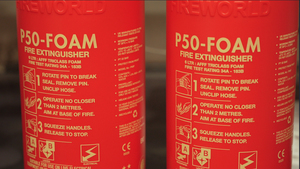

|
Edward Lowton
Editor |


|
| Home> | Premises management/maintenance | >Fire safety | >Helping improve your plant's fire safety |
Helping improve your plant's fire safety
03 January 2023
A new fire extinguisher - which is non-corrosive and requires no external maintenance - is radically reducing health and safety budgets and improving organisations' environmental credentials, says Laura Hutt

AFTER UNDERTAKING a health and safety audit, decision-makers look for ideal solutions. Solutions that enhance operational health and safety, minimise service and maintenance hassles and maximise cost-effectiveness. If they find a product that does all of these, without compromising quality or environmental performance, they consider they've struck gold.
Addressing fire risks in the industrial workplace
It's difficult to imagine a fire of any scale in the workplace. However, being prepared and knowing how to respond when fire strikes, ensures the health and safety of all is not compromised.
The best safety measures to implement are fire hazard risk assessments to identify and understand the particular risks and consider how to address them for your specific operation.
Secondly, employees need to be trained on the various fire hazards, as well as knowing what to do in the event of a fire. It's important to understand that everyone is responsible for fire prevention, protection and safety, so it's essential that anyone working within the plant is regularly trained - especially when new facilities and materials are introduced on site.
Some of the most common industrial fire risks include:
- Flammable liquids and gases - ensure you are aware of all the flammable liquids and gases within your plant. The Health and Safety Executive (HSE) recommends using chemical safety data sheets to inform the handling and storage of hazardous chemicals. By labelling the chemicals that are flammable and storing those chemicals a safe distance away from oxidizers, you can put adequate procedures in place, provide training and monitor compliance on the handling of flammable gases and liquids.
- Faulty electrical equipment - regularly inspect and maintain electrical equipment and look for damaged cabling or loose cables. Ensure you replace any faulty equipment and don’t overload circuits, sockets or outlets. Limit the use of extension leads for large machinery or equipment.
- Combustible dusts - dust explosions occur in various industries, such as chemical, wood working, agricultural, coal mining and food. Many companies are unaware of the hazards posed by dust. Some measures you can undertake to mitigate risk include regular housekeeping to prevent dust from accumulating and ensuring adequate ventilation and filtration.
An all-in-one fire extinguisher solution
The design of Britannia Fire's P50 composite fire extinguisher is patent-protected to have better corrosion resistance with minimal servicing. This innovative fire extinguisher carries a ten-year guarantee, and it can be easily self-maintained with annual checks in the interim, removing the need for costly service engineer visits. It can then be refurbished for another ten years of service.
Resistant to drops, scratches and dents, the P50 also meets the standards required for use on several different types of fires, including ordinary combustibles, flammable liquids and live electrical equipment. This removes the need for multiple fire extinguishers on site, eliminating the risk of the wrong type of extinguisher being used for any given application. All of this makes the P50 perfect for high-risk environments.
Developed by Britannia Fire's founder, Roger Carr, the P50 patent hinges on its hi-tech materials (eg HDPE and Aramid fibre) and manufacturing process.
Ultimately, facility managers and health and safety managers want to find one solution and avoid the confusion of needing different classes of fire extinguishers. The P50 is a game-changer - it's greener, lighter, safer, more cost-effective and has a longer lifespan.
Laura Hutt is operations manager at Britannia Fire
For more information:
Tel: 01508 488 416
- No related articles listed


















